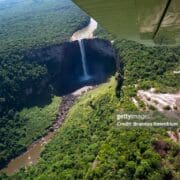By Tash Van Doimen, Rae Wiltshire & Dr. Terrence Blackman
News Americas, NEW YORK, NY, Mon. Sept. 11, 2023: In an inspiring convergence of thought leaders, the recent event titled “Navigating a Changing Guyana: Pathways to Prosperity in the Era of Oil and Gas” emerged as a pivotal platform for illuminating the evolving landscape of opportunities in Guyana. Orchestrated by the Guyana Business Journal & Magazine (GBJ), the Caribbean Policy Consortium, (CPC), Guyana SPEAKS, and the Guyana UK Social Development Association (GUSDA), the dialogue unfolded at Chancellor’s Hall, Senate House, University of London. Beyond being a mere gathering, this event symbolized a potent catalyst for unlocking the promising horizons within Guyana.
Featuring a diverse range of expertise spanning the private and public sectors, the expert panelists including Mr. Carl Greenidge, Former Minister of Foreign Affairs and Advisor on Borders; Mr. Alistair Routledge, President of Esso Exploration and Production Guyana Ltd; Dr. Riyad Insanally, Former Guyanese Ambassador to the United States; Dr. Juanita Cox, Guyana SPEAKS; Dr. Rosh Khan, President – ACE Consulting Group, SocialRank Media, Masterclass Institute (Franklin Covey Guyana); Michele Small, Development Finance Professional; and Mr. Faizal Khan, Chairman, British Chamber of Commerce(BritCham) Guyana shared with the audience profound insights into the challenges and prospects inherent in Guyana’s burgeoning oil and gas sector.
The event included a comprehensive Oil and Gas Update for the UK Guyanese Diaspora, presented by Mr. Alistair Routledge, President of Esso Exploration and Production Guyana Ltd., ExxonMobil’s subsidiary company in Guyana and the operator of the Stabroek Block. His presentation offered a well-structured overview of the partnership between a major energy company and Guyana, tracing its evolution from initial explorations and first oil to the energy company’s present-day activities and future projections.
Mr. Routledge’s insights painted a vivid picture of Guyana on the cusp of remarkable transformation. Noteworthy among his disclosures was the projection that Guyana’s annual government revenue from the energy sector is poised to soar to as much as US$10 billion by 2030. He highlighted investments totaling over US$40 billion committed to date, including the groundbreaking Whiptail project, a US$13 billion endeavor set to become the most significant single investment in Guyanese history.
Mr. Routledge unveiled a vision of a strategic partnership binding the company and the people of Guyana, driven by a shared mission to generate substantial revenue and secure the nation’s progress. The necessity for this partnership between the energy company, the government, and the people of Guyana was echoed by Dr. Insanally, who opined that finding pathways to a prosperous and equitable Guyana, not just for this generation but for future generations, was central to the future of the country.
According to Mr. Routledge, one of the critical elements of this partnership has been the Center for Local Business Development (CLBD), established in 2017, which actively supports Guyanese businesses through training and industry knowledge. The energy company’s investment of over US$900 million in Guyanese businesses signifies substantial progress and a commitment to fostering local economic growth.
Mr. Routledge further underlined the necessity of continuous efforts to empower Guyanese businesses while avoiding over-reliance on one industry alone—a problem of the resource curse. With over 5,000 Guyanese workers employed, the oil industry has made large investments in retraining technicians from other sectors as a way of diversifying, enhancing, and aligning local skill sets with 21st-century market demands. Finding ways to leverage these skills across industries will be an important challenge for Guyana.
The company has committed to addressing Guyana’s long-standing, multi-generational electricity generation challenges by providing the fuel for a natural gas-fueled power generation plant that the government predicts will cut prices in half for households and businesses, while reducing pollution substantially.
EEPGL’s commitment extends beyond economic contributions to encompass social and environmental initiatives. Through the Greater Guyana Initiative, the company has invested USD 100 million in capacity building, healthcare, and community support. Collaborations with their foundation have enabled initiatives focused on marine awareness, ecosystem restoration, and educational empowerment, particularly for women.
The journey by ExxonMobil in Guyana traces back to 1999, with an agreement that laid the foundation for the discoveries made since. After years of exploration, the pivotal moment arrived in 2015. Mr. Routledge emphasized the profound impact of this discovery, highlighting the role those technological advancements played in enabling drilling at previously unreachable water depths.
This landmark discovery in the Stabroek Block propelled an ambitious development plan to reshape Guyana’s economic landscape. Challenges, from geopolitical intricacies to technological innovations, accompanied the journey from discovery to realization.
The energy company’s role characterizes this partnership as a contract operator entrusted with harnessing Guyana’s abundant resource wealth. EEPGL President Routledge highlighted the significant contributions to Guyana’s Natural Resource Fund as evidence of his company’s commitment to transparency and fair distribution of revenues.
Mr. Routledge’s presentation also addressed the importance of socio-economic and political stability in Guyana for the energy company’s investments. When emphasizing the company’s preference for politically stable destinations, there was an opportunity to reaffirm EEPGL’s commitment to the rule of law within Guyana and to speak more explicitly to evident local frustration about the pace of the impact of the energy discoveries on the lives of ordinary citizens. There was also an opportunity to address questions about focusing on a single Gas to Shore project rather than a comprehensive Guyanese Gas Master Plan, which may be a logical next step for the Government.
Mr. Carl Greenidge, Former Minister of Foreign Affairs and Advisor on Borders, added a distinct perspective to the dialogue. He engaged with the audience on the role of local businesses in the operations. Greenidge’s remarks emphasized the importance of understanding the functions and needs, particularly concerning providing services and goods.
He emphasized the opportunities for Guyanese businesses to contribute to the production process by supplying various goods and services that the energy company requires. Greenidge highlighted the significance of efficient production processes, the education of the local labor force, and the potential for businesses to package specialized skills for sale. Greenidge’s argument for building concrete pathways to connect various business community sectors to emerging opportunities must be amplified and acted upon by Guyanese policymakers.
The emerging partnership between the Guyanese people and EEPGL can exemplify the power of collaboration in shaping a promising and sustainable Guyanese future. If embraced with mutual respect by all parties, it will stand as evidence that when industry leaders align with a nation’s aspirations, the possibilities are boundless, and the impact is profound. The comprehensive range of initiatives underway will transform Guyana’s socio-economic and political landscape. Will it be a transformation that enhances the nation’s well-being and that our grandchildren will look upon with pride?
The answer to this question is entirely up to us; trite and true, tomorrow is a function of what we do together today.
Tash Van Doimen was born and raised in Georgetown, Guyana. She holds a master’s degree in development policy from the KDI School of Public Policy and Management with a double major in International and Sustainable Development. She used this opportunity to examine Guyana’s oil industry and the nexus between economic development and environmental implications. Ms. Van Doimen began her journalism career, covering hard news and featured articles. Ms. Van Doimen began her career as a Foreign Service Officer, representing Guyana on multiple forums and speaking on various issues aligned with Guyana’s Foreign Policy.
Rae Wiltshire is a storyteller and art student. His multiple playwriting awards include the 2015 National Drama Festival’s Best New Guyanese Play. His works grace The Guyana Annual. The recent Guyana Prize for Literature in Drama 2022 honored “Don’t Ask Me Why,” also shortlisted for “Adults.” Graduating with honors in literature and linguistics from the University of Guyana, his academic work informs scriptwriting, directing, and cinematography.
Dr. Terrence Richard Blackman, associate professor of mathematics and a founding member of the Undergraduate Program in Mathematics at Medgar Evers College, is a member of the Guyanese diaspora. He is a former Dr. Martin Luther King Jr. Visiting Professor at MIT and a Visitor to The School of Mathematics at The Institute for Advanced Study. Dr. Blackman has previously served as Chair of the Mathematics Department and Dean of the School of Science, Health, and Technology at Medgar Evers College, where he has worked for almost thirty years. He graduated from Queen’s College, Guyana, Brooklyn College, CUNY, and the City University of New York Graduate School. He is the Founder of the Guyana Business Journal & Magazine.



